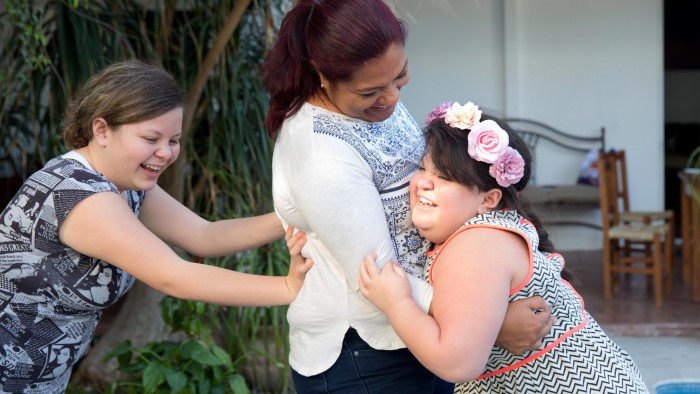Hurler and Morquio syndromes: growing up with a condition that kills

Roula Khalaf, Editor of the FT, selects her favourite stories in this weekly newsletter.
Jesús Navarro and his wife, Ana Rios, knew something was wrong as soon as their second daughter was born. Ximena could not tolerate her mother’s milk and had difficulty breathing.
But despite the fact that Jesús was a surgeon and Ana an obstetrician-gynaecologist, they had no clue what was the matter. Nor did the specialists who examined her over the course of the following months, ran batteries of tests and prescribed medicine.
Dr Rios was, at the time, halfway through a doctorate in molecular biology, and it was only when a genetics expert she knew at the university intervened that Ximena’s condition was finally identified.

Although the geneticist had guessed immediately from the photograph that Ana showed her, she said nothing until samples sent to laboratories in Germany and Brazil confirmed Ximena was suffering from mucopolysaccharidosis (MPS) type one, also known as Hurler syndrome.
“When we got the diagnosis, we went to the biology textbooks and learned that children die a painful death, with physical complications, blind and deaf, and that there was no treatment,” Dr Navarro says. “It was devastating.”
Type one is the most serious of seven mucopolysaccharidosis variants. Sufferers of MPS cannot produce particular enzymes needed to break down certain nutrients in the body’s cells.
The resulting build-up causes worsening damage to the bones, heart, joints, respiratory system and central nervous system, leading to deformities, stunted growth, mental impairment and other problems.
Dr Navarro says that only about 1,000 Mexicans suffer from Hurler syndrome and 5,000 people — in a country of 120m — have some variant of MPS. As a result, diagnosis is often more miss than hit.
The good news for Ximena was that she was being treated at a hospital in Guadalajara in western Mexico that was, at the time, offering a pioneering MPS treatment to four other children, replacing the enzyme they are lacking intravenously. Ximena’s diagnosis came on a Tuesday and by that Thursday she had joined the programme, her father recalls.
“We were very lucky,” he says. “Without the treatment, she would have died from all the complications — untreated, children have a very bad quality of life and typically die before they are seven.”
Instead, Ximena, who at that time was 19 months old, was suddenly able to eat and sleep. She is now 12, goes to school, enjoys outings to the zoo and the circus, plays with her sister and has normal hormonal development for her age, although some mental delay, according to her father.

In Mexico City, siblings Brenda, Alfredo and Joaquín Torres Gil all suffer from a different MPS variant — type four, known as Morquio syndrome.
While people with Morquio syndrome can live to be adults, their growth has been stunted and they need oxygen to sleep. But just as difficult is the lack of understanding about their disease.
“We’re not circus animals, we are people,” Brenda says.

Ximena’s and the Torres Gil siblings’ conditions are both hereditary. Both parents need to be carriers and Joaquina Gil, the mother of the three Morquio sufferers, has two other healthy daughters. The risk of two carrier parents having an affected child is 25 per cent.
Brenda Torres Gil, who is now 32, puzzled doctors for years. It was not until her brother, Alfredo, 18, started manifesting symptoms as a baby that they were both diagnosed.
Neither sibling, nor their younger brother Joaquín, 14, is receiving enzyme replacement treatment for their condition. “We are invisible to the government,” says their mother.
It can be hard to get treatment for MPS because of the different criteria applied by Mexico’s various state health insurers. For example, the Seguro Popular, or Popular Insurance — a service for people without formal jobs that serves 54m people, nearly half of Mexico’s population — has a Catastrophic Expenditure Protection Fund totalling 13bn pesos ($640m) this year, but that only covers treatment for three of the seven MPS variants, including MPS one but excluding MPS four.
Therapy is time consuming and expensive. Ximena must be hooked up to an IV drip for four hours at a time. Family holidays and other outings are tailored around her weekly therapy.
“It has changed our life,” Dr Navarro says. He says only one company — Genzyme, a unit of French pharmaceuticals giant Sanofi — makes the enzyme replacer that Ximena needs. Her treatment costs the Mexican state $7,700 every week.
Dr Navarro set up the Mexican Organisation for Rare Diseases (OMER), in 2014. OMER runs annual seminars to educate doctors. “The ego of doctors who think they can cure everything without referrals, saying ‘I’m sure it’s this’” remains a big barrier, he says.
He says that currently only about 500 children nationwide are receiving MPS treatments, fewer than half of them Hurler syndrome sufferers, and only 25 out of 300 drugs for rare diseases are authorised in Mexico.
“That’s why we set up the organisation — so that everyone can get treatment,” Dr Navarro says.
Ximena’s therapy is slowing down the spread of her disease. But the drugs cannot cure it. “The only hope for future generations is access to innovation,” Dr Navarro says. “A lot of children now have a more normal life, that gives us the strength to go on.”
Ms Gil knows Morquio sufferers can die before middle age. “The day they are gone, I’ll have to go too . . . I won’t be able just to let them go.”
Comments